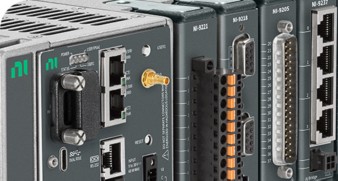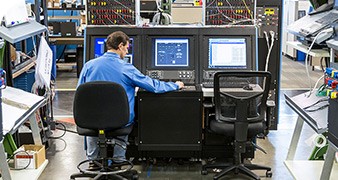Data Acquisition Using NI-DAQmx and LabVIEW Course Overview
In the Data Acquisition Using NI-DAQmx and LabVIEW Course, you will explore the fundamentals of data acquisition using sensors, NI data acquisition hardware, and LabVIEW. The first part of this class teaches the basics of hardware selection, including resolution and sample rate, and the foundation of sensor connectivity, including grounding and wiring configurations. The second part of this class focuses on using the NI-DAQmx driver to measure, generate, and synchronize data acquisition tasks. You will learn about programming finite and continuous acquisitions, as well as best practices in hardware/software timing, triggering, and logging. In this class, you will get hands-on experience configuring and programming NI data acquisition hardware using NI-DAQmx and LabVIEW.
Available in the following formats:
Private training not available for this course
Course Objectives:
-
Develop integrated, high-performance data acquisition systems that produce accurate measurements
-
Acquire data from sensors, such as thermocouples and strain gages, using NI data acquisition hardware
-
Apply advanced understanding of LabVIEW and the NI-DAQmx API to create applications
-
Eliminate measurement errors due to aliasing and incorrect signal grounding
-
Initiate measurements using hardware and software triggering
-
Acquire and generate single-point and buffered analog waveforms
-
Acquire and generate digital signals
-
Use signal conditioning to improve the quality of acquired signals
-
Synchronize multiple data acquisition operations and devices
Course Details
Duration
-
Instructor-led Classroom: Two (2) days
-
Instructor-led Virtual: Three (3) days, five-and-a-half-hour sessions
-
On-Demand: 4.5 hours (exercises as a supplement)
Audience
-
Developers using LabVIEW with NI data acquisition hardware to create data acquisition applications
-
Users familiar with the DAQ Assistant or basic NI-DAQmx code that want to expand their programming capabilities
-
Users new to PC-based data acquisition and signal conditioning
Prerequisites
-
LabVIEW Core 1
-
LabVIEW Core 2
NI Products Used
If you take the course On-Demand:
-
NI DAQmx 2022 Q3
-
LabVIEW 2022
If you take the course in an instructor-led format:
-
LabVIEW
-
NI-DAQmx
-
CompactDAQ Chassis
-
C Series analog input, analog output, and digital I/O modules
Training Materials
-
Virtual instructor-led training includes digital course material that is delivered through the NI Learning Center.
-
NI virtual instructor-led training is delivered through Zoom, and Amazon AppStream/LogMein access is provided to participants to perform the exercises on virtual machines equipped with the latest software.
Cost in Credits
-
On-Demand: Included with software subscription and enterprise agreements, or 5 Education Services Credits, or 2 Training Credits
-
Public virtual or classroom course: 20 Education Services Credits or 6 Training Credits
-
Private virtual or classroom: 140 Education Services Credits or 40 Training Credits
Data Acquisition Using NI-DAQmx and LabVIEW Course Outline
| Lesson | Overview | Topics |
|---|---|---|
Measuring Analog Input | Select and connect to the hardware, configure the DAQmx task appropriately, and validate an analog signal. |
|
Generating Analog Output | Select and connect to the hardware, configure the DAQmx task appropriately, and validate an analog signal. |
|
Generating and Reading Digital Signal | Select and connect to hardware, configure the DAQmx task appropriately, and validate a digital signal. |
|
Choosing a Signal to Explore | Choose a specific signal and configure the DAQmx task, including any special signal conditioning needs. |
|
Programming with the NI-DAQmx API | Use NI-DAQmx API in LabVIEW to automate data communication between a DAQ device and a computer. |
|
Programming Multiple Channels | Examine various methods for multi-channel task creation and their applications. |
|
Triggering on a Specific Condition | Acquire data on a specific condition and explore how to use hardware sources as triggers. |
|
Exploring Advanced Timing and Synchronization Methods | Use an appropriate method for synchronizing multiple DAQ tasks. |
|
Logging Measurement Data to Disk | Log data to a TDMS file to store and analyze post-acquisition. |
|
Exploring System Considerations | Explore additional aspects of building a data acquisition system. |
|
Continue your learning path
Developing Embedded Applications Using CompactRIO and LabVIEW Real-Time
Translate embedded system requirements into scalable software architecture.
LabVIEW Instrument Control
Learn to programmatically control instruments using LabVIEW. Understand the benefits of instrument control, explore industry applications, and gain in-depth knowledge of how LabVIEW communicates with instruments.
Software Engineering for Test Applications
Build upon foundation by focusing on LabVIEW tools and industry practices that aid in the definition, management, design, development, validation, and deployment of a quality solution.
Upgrade to Membership
Planning to take three or more NI instructor-led courses within one year?
A Training Membership provides cost-effective, unlimited access to all NI public classroom and public virtual courses, along with unlimited certification vouchers.


